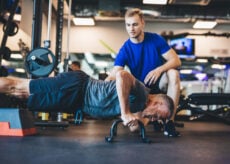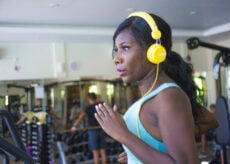The Top 5 Isometric Exercises You Need to Be Doing

You’ve undoubtedly heard of exercise and most likely engage in it regularly, but do you know when you’re doing isometric exercises? What does “isometric” mean? And can you use isometric exercises to build muscle? The answer may be unexpected, but it is a resounding yes! Using isometrics is a great way to improve your tone, the strength of your muscles, ligaments, and tendons and even improve your overall health.
What Are Isometric Exercises?
Normal exercises involve shortening and contracting the muscle. An isometric exercise is different in that the length of the muscle does not change, and there is no movement at the joint. Instead, a static contraction is performed, usually while the limb is pressed against something unmovable, like a wall or the floor.
Think of isometrics as tensing your muscles as hard as you can, holding that state, and then releasing.
What Are the Benefits of Isometric Exercises?
While all exercise is beneficial, isometric exercise has some special benefits not always shared by its counterparts. For example:
- Less stress on joints—because isometric exercise dictates that the muscle length remain the same, and no weight is used, there is very little, if any, stress placed on the joints.
- Great for rehabilitation work—because isometric exercises don’t require movement and don’t place stress on your joints, this type of exercise is perfect for rehabilitation purposes as well as for those with arthritis or other painful joint conditions.
- Do isometrics anywhere at any time—another great benefit of isometric exercise is that it can be done virtually anywhere. Since no equipment or weights are needed, you can simply stop what you’re doing, find something on which to push (or to pull) and you’re on the path to strengthening and building muscle, just like that. It couldn’t be more convenient.
- Increase strength—it may not seem possible, but yes, you can become stronger just by engaging in isometric exercises. Isometrics are a gentle way to strengthen your muscles while also helping to strengthen your ligaments and tendons.
- Efficient—yes, isometrics are efficient as well. Since each exercise takes only a minute or two (at the most) to complete, it’s a quick, easy way to get in some exercise even for those who may be short on time. And, the fact that you can easily perform these exercises in the privacy of your own home means using isometrics is a great way to get in your exercise.
- Build muscle—yes, you can even use isometric exercises to build muscle. Even though you are not moving through a range of motion, your muscle fibers are still firing and being challenged. Isomeric exercises engage the muscle fibers and promote hypertrophy (i.e., muscle growth).
- Strengthen your tendons and ligaments—this static type of contraction can help strengthen tendons and ligaments with little worry of injury since there is no stress placed on joints.
- Lower blood pressure and improve overall health—it’s true! Doing isometric exercise has been shown to reduce resting blood pressure and improve health markers across the board.
Try These Isometric Exercises to Build Muscle
When doing isometric exercise, you’ll be either pushing on an immovable object or pulling on one. Often, folks will use a wall or some other heavy object to push against or to pull. Basically, you are firing the muscle fibers into action without any actual movement. Try doing these exercises for an impactful, yet gentle workout.
Plank—(targets the core and abdominals) this well-known exercise is one you may have been doing for years but never realized was an isometric exercise. Begin in a push-up position on the floor (or bend your elbows to lower your upper body so that you are resting on your forearms rather than your palms). Squeeze the muscles in your abdomen and hold this position for up to a minute at a time. Release, rest, and repeat.
Palm Prayer—(targets the chest) while standing, press both of your palms against each other in front of your chest. You will look like you are about to say a prayer. Press your hands together as hard as you can for 20 – 30 seconds and release. Repeat three times.
Wall Push—(targets your shoulders and upper back) stand facing a wall and take a giant step backward. Next, while maintaining a straight back and with your hands outstretched, let your body move toward the wall until your palms are flat against it. Bend your elbows slightly and “push the wall away from you” as hard as you can for up to 20 seconds. Release, step back, and repeat.
Wall Squat—(targets legs and glutes) from a standing position with your back against a wall and your feet about a foot and a half in front of you, place your hands on your hips and slowly bend your knees and lower your body toward the ground. Pause when your knees are bent at a 45-degree angle and hold for a 20-second count. Go longer if you can. You can work up to longer and longer holds with this exercise.
Towel Curl—(targets the muscles in your arms) this exercise will work the muscles in your biceps, triceps, and shoulders. Procure a towel (it must be long enough to place under your foot and also grasp with both hands). Hold the towel firmly in each hand and with your foot firmly on the middle of the towel. Grasping the towel in each hand, pull upward as hard as you can and hold the contraction for up to 20 seconds. Release and repeat.
With these simple exercises, you’ll be able to work out your entire body anytime, anywhere with no equipment. Now that’s what I call a no-excuses muscle-building workout!






